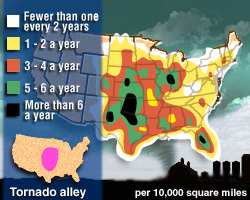 |
| TORNADO SAFETY |
 |
| In an average year, 800 tornadoes are reported nationwide, resulting in 80 deaths and over 1,500 injuries. A tornado is defined as a violently rotating column of air extending from a thunderstorm to the ground. The most violent tornadoes are capable of tremendous destruction with wind speeds of 250 mph or more. Damage paths can be in excess of one mile wide and 50 miles long. Therefore, personal safety is of the utmost importance. |
 |
 |
| IF A TORNADO WATCH IS ISSUED: Tune into your weather radio and stay tuned to future weather updates and listen for possible warnings. Check on the elderly, children that may be in school or at a friend's house, and your pets. Stay close to safe shelter in the event a warning is issued and be ready to act quickly. AT HOME DURING A TORNADO: Go at once to the basement, storm cellar, or the lowest level of the building. If there is no basement, go to an inner hallway or a smaller inner room without windows, such as a bathroom or closet. Get away from the windows. Go to the center of the room. Stay away from corners because they tend to attract debris. Get under a piece of sturdy furniture such as a workbench or heavy table or desk and hold on to it. Use arms to protect head and neck. If in a mobile home, get out and find shelter elsewhere. AWAY FROM HOME: Go to the basement or to an inside hallway at the lowest level. Avoid places with wide-span roofs such as auditoriums, cafeterias, large hallways, or shopping malls. Get under a piece of sturdy furniture such as a workbench or heavy table or desk and hold on to it. Use arms to protect head and neck IF YOU ARE OUTDOORS: If possible, get inside a building. If shelter is not available or there is no time to get indoors, lie in a ditch or low-lying area or crouch near a strong building. Be aware of the potential for flooding. Use arms to protect head and neck IF IN A CAR: Never try to outdrive a tornado in a car or truck. Tornadoes can change direction quickly and can lift up a car or truck and toss it through the air. Get out of the car immediately and take shelter in a nearby building. If there is no time to get indoors, get out of the car and lie in a ditch or low-lying area away from the vehicle. Be aware of the potential for flooding. |
| SAFETY STEPS TO FOLLOW |
| WHERE TORNADOES OCCUR |
| NOAA |
| COMMON MYTHS ABOUT TORNADOES |
| MYTH: Areas near rivers, lakes, and mountains are safe from tornadoes. FACT: No place is safe from tornadoes. In the late 1980's, a tornado swept through Yellowstone National Park leaving a path of destruction up and down a 10,000 ft. mountain. MYTH: The low pressure with a tornado causes buildings to "explode" as the tornado passes overhead. FACT: Violent winds and debris slamming into buildings cause most structural damage. MYTH:Windows should be opened before a tornado approaches to equalize pressure and minimize damage. FACT: Opening windows allows damaging winds to enter the structure. Leave the windows alone; instead, immediately go to a safe place. |
| NOAA |
| NOAA |
| A FEW LINKS TO TRY |
 |